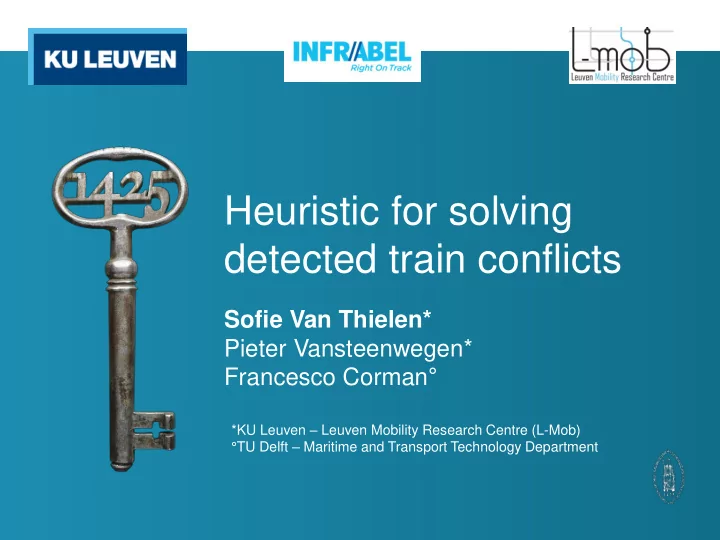

Heuristic for solving detected train conflicts Sofie Van Thielen* Pieter Vansteenwegen* Francesco Corman ° *KU Leuven – Leuven Mobility Research Centre (L-Mob) °TU Delft – Maritime and Transport Technology Department
Introduction • Motivation • Goal
Motivation • Normal situation: • Conflict: 3
Motivation • In practice: Real-time management is performed manually. 4
Problem description Given one (or more) conflicts, present different good solutions with the corresponding total delay. In a tool that is directly accessible for the dispatchers. 5
Simulation software
Program Infrastructure (XML format) Simulation Output software Timetable (XML format) - Delay scenarios - Conflict prevention techniques - Goal function 7
Characteristics simulation • 1-hour window: 6-7 AM • ± 150 trains • Delay scenarios • Study area • Evaluation criteria 8
Study area • Brugge-Gent-Denderleeuw (in Belgium) Oostende Brugge Denderleeuw Gent 9
Evaluation criteria • Total/maximal/average train delay • Total/maximal/average passenger delay • Total/maximal/average exit delay 10
Heuristic
Rerouting • Limited to station areas: • Minimize passenger delays or secondary delays • Optimization problem solved using Cplex 12
Optimization model for rerouting 13
Optimization model for rerouting 14
Optimization model for rerouting 15
Optimization model for rerouting 16
Conflict prevention technique If the conflict still exists after rerouting, then rescheduling is performed. Decision is based on heuristic: o Minimize the effect of conflicts o Investigate the progress during the next hour o Choose option with least total secondary delay 17
Heuristic Total secondary delay of A Total secondary delay of 1st train A B, given initial delay then train B Total secondary delay of B from A Conflict A - B Total secondary delay of B 1st train B Total secondary delay of then train A A, given initial delay Total secondary delay of B from A 18
Results
Preliminary results Strategy Average secondary Maximal secondary delay delay FCFS – rerouting 45,26 3022 FCFS – passenger rerouting 45,37 3022 FCFS – no rerouting 48,03 3022 Heuristic – rerouting 34,38 3017 Heuristic – passenger rerouting 47,01 3017 Heuristic – no rerouting 43,13 3017 20
Average computation time (in s) Strategy Simulation FCFS – rerouting 242,82 FCFS – passenger rerouting 250,29 FCFS – no rerouting 260,56 Heuristic – rerouting 515,52 Heuristic – passenger 523,70 rerouting Heuristic – no rerouting 537,25 21
Conclusion & further work
Conclusion & further work • Improve heuristic and rerouting procedure • Optimize the number of rerouting optimizations • Examine differences with second or third order propagations in heuristic what is the impact? is it possible to limit search area and create a “impact zone”? 23
Heuristic for solving detected train conflicts Sofie Van Thielen* Pieter Vansteenwegen* Francesco Corman ° *KU Leuven – Leuven Mobility Research Centre (L-Mob) °TU Delft – Maritime and Transport Technology Department
Recommend
More recommend